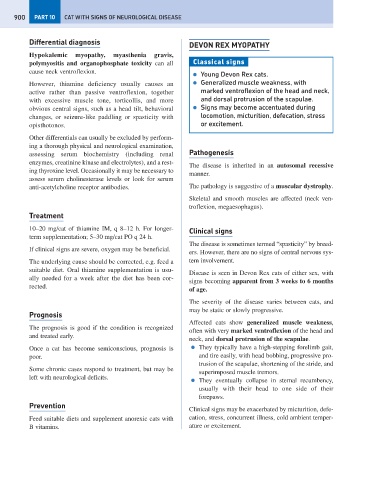Page 908 - Problem-Based Feline Medicine
P. 908
900 PART 10 CAT WITH SIGNS OF NEUROLOGICAL DISEASE
Differential diagnosis DEVON REX MYOPATHY
Hypokalemic myopathy, myasthenia gravis,
polymyositis and organophosphate toxicity can all Classical signs
cause neck ventroflexion.
● Young Devon Rex cats.
However, thiamine deficiency usually causes an ● Generalized muscle weakness, with
active rather than passive ventroflexion, together marked ventroflexion of the head and neck,
with excessive muscle tone, torticollis, and more and dorsal protrusion of the scapulae.
obvious central signs, such as a head tilt, behavioral ● Signs may become accentuated during
changes, or seizure-like paddling or spasticity with locomotion, micturition, defecation, stress
opisthotonos. or excitement.
Other differentials can usually be excluded by perform-
ing a thorough physical and neurological examination,
assessing serum biochemistry (including renal Pathogenesis
enzymes, creatinine kinase and electrolytes), and a rest-
The disease is inherited in an autosomal recessive
ing thyroxine level. Occasionally it may be necessary to
manner.
assess serum cholinesterase levels or look for serum
anti-acetylcholine receptor antibodies. The pathology is suggestive of a muscular dystrophy.
Skeletal and smooth muscles are affected (neck ven-
troflexion, megaesophagus).
Treatment
10–20 mg/cat of thiamine IM, q 8–12 h. For longer- Clinical signs
term supplementation; 5–30 mg/cat PO q 24 h.
The disease is sometimes termed “spasticity” by breed-
If clinical signs are severe, oxygen may be beneficial.
ers. However, there are no signs of central nervous sys-
The underlying cause should be corrected, e.g. feed a tem involvement.
suitable diet. Oral thiamine supplementation is usu-
Disease is seen in Devon Rex cats of either sex, with
ally needed for a week after the diet has been cor-
signs becoming apparent from 3 weeks to 6 months
rected.
of age.
The severity of the disease varies between cats, and
may be static or slowly progressive.
Prognosis
Affected cats show generalized muscle weakness,
The prognosis is good if the condition is recognized
often with very marked ventroflexion of the head and
and treated early.
neck, and dorsal protrusion of the scapulae.
Once a cat has become semiconscious, prognosis is ● They typically have a high-stepping forelimb gait,
poor. and tire easily, with head bobbing, progressive pro-
trusion of the scapulae, shortening of the stride, and
Some chronic cases respond to treatment, but may be
superimposed muscle tremors.
left with neurological deficits.
● They eventually collapse in sternal recumbency,
usually with their head to one side of their
forepaws.
Prevention
Clinical signs may be exacerbated by micturition, defe-
Feed suitable diets and supplement anorexic cats with cation, stress, concurrent illness, cold ambient temper-
B vitamins. ature or excitement.

